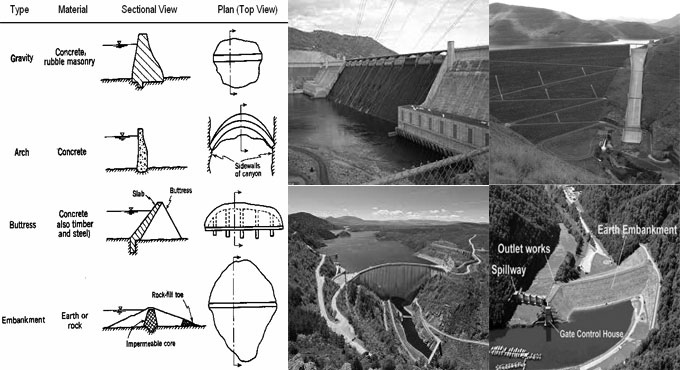
Different types of Dams
Depending on the design, the dams can be categorized as follow :-
Gravity Dams: The size of the gravity dams is immense. It is formed with concrete or stone masonry. It?d objective is to retain huge volumes of water. With the help of concrete, the load of the dam remains in a position to resist the horizontal force of water moving towards it. Due to this fact, it called as a gravity dam. Gravity mainly retains the dam right down to the bottom, resisting water from toppling it over.
Instances of Gravity dam: Grand Coulee Dam (USA), ( Nagarjuna Sagar Dam (India) and Itaipu Dam ( Between Brazil and Paraguay).
Earth Dams: An earth dam is produced with earth (or soil) by condensing subsequent layers of earth, applying basically the most watertight materials to build up a core and adding extra absorbent materials on the upstream and downstream sides. A facing of crushed stone can resist corrosion occurred due to wind or rain, and an abundant spillway, usually of concrete, withstand catastrophic washout of water outstripping the dam.
Earth dam withstands the forces functioned upon it mainly due to shear strength of the soil. Though the load of the earth dam also allows in withstanding the forces, the structural behavior of an earth dam vary as compared to that of a gravity dam. The earth dams are usually constructed in large valleys which contain flat slopes at flanks (abutments).The foundation requirements are not so rigid as compared to those of gravity dams.
Instances of earthfill dam: Rongunsky dam (Russia) and New Cornelia Dam (USA).
Rockfill Dams: A rockfill dam is built up with rock fragments and boulders of enormous size. An impermeable membrane is placed on the rockfill on the upward side to lessen the leakage through the dam. The membrane is usually built up with cement concrete or asphaltic concrete. In former rockfill dams, steel and timber membrane were also frequently utilized, but now they are obsolete.
A dry rubble cushion is placed among the rockfill and the membrane for dispersing the water load and for providing support to the membrane. Normally, the rockfill dams contain a watertight earth core inside the center to examine the leakage in place of an impermeable upstream membrane. The earth core is placed against a dumped rockfill. It?s important to provide sufficient filters among the earth core and the rockfill on the upward and downward sides of the core so that the soil particles will not be conveyed by water and piping doesn?t happen.
Instances of rockfill dam: Mica Dam (Canada) and Chicoasen Dam (Mexico)
Arch Dams: An arch dam is twisted in plan, having its convexity in the order of the upward side. An arch dam disperses the water stress and other forces mainly to the abutments through arch action. An arch dam is ideal for narrow canyons containing sturdy flanks which have the capability to withstand the force formed with the arch action.
The portion of an arch dam is about triangular similar to a gravity dam though the portion is comparatively thinner. The arch dam may contain a single curvature or double curvature inside the vertical plane. Normally, the arch dams of double curvature are inexpensive and are utilized in practice.
Examples of Arch dam: Hoover Dam (USA) and Idukki Dam (India)

Buttress Dams: Buttresses belong to triangular concrete partitions which are used to transfer the water pressure from the deck slab to the foundation. Buttresses refer to compression members which are normally arranged all through the dam site each 6 to 30 meter, depending on the size and design of the dam.
Buttress dams are usually belonged to hollow dams as the buttresses can?t develop a solid wall extending during a river valley. The deck is commonly a reinforced concrete slab that is supported among the buttresses, which are frequently place uniformly.
To get more information, go through the following article civilengineeringdaily.com

